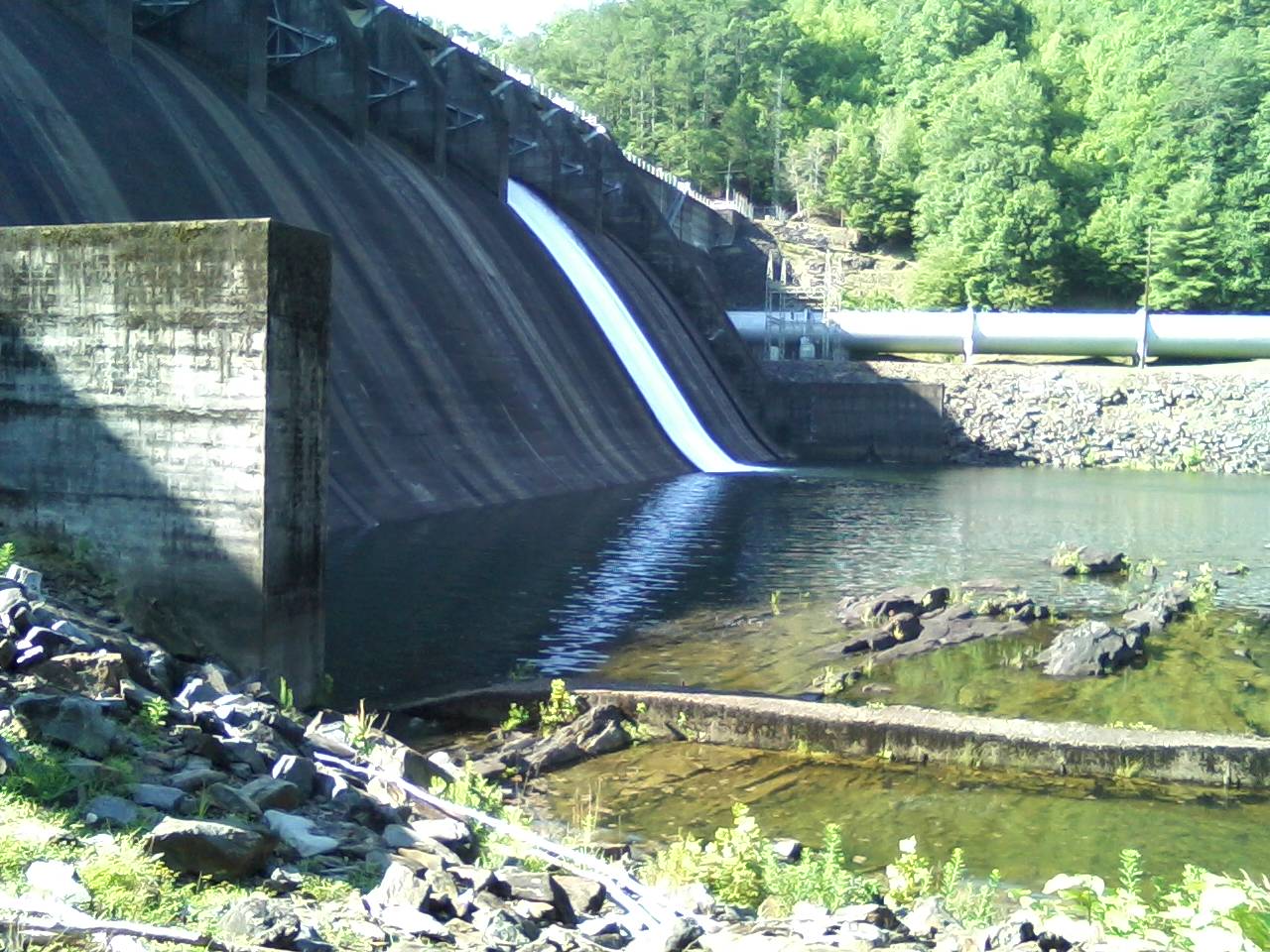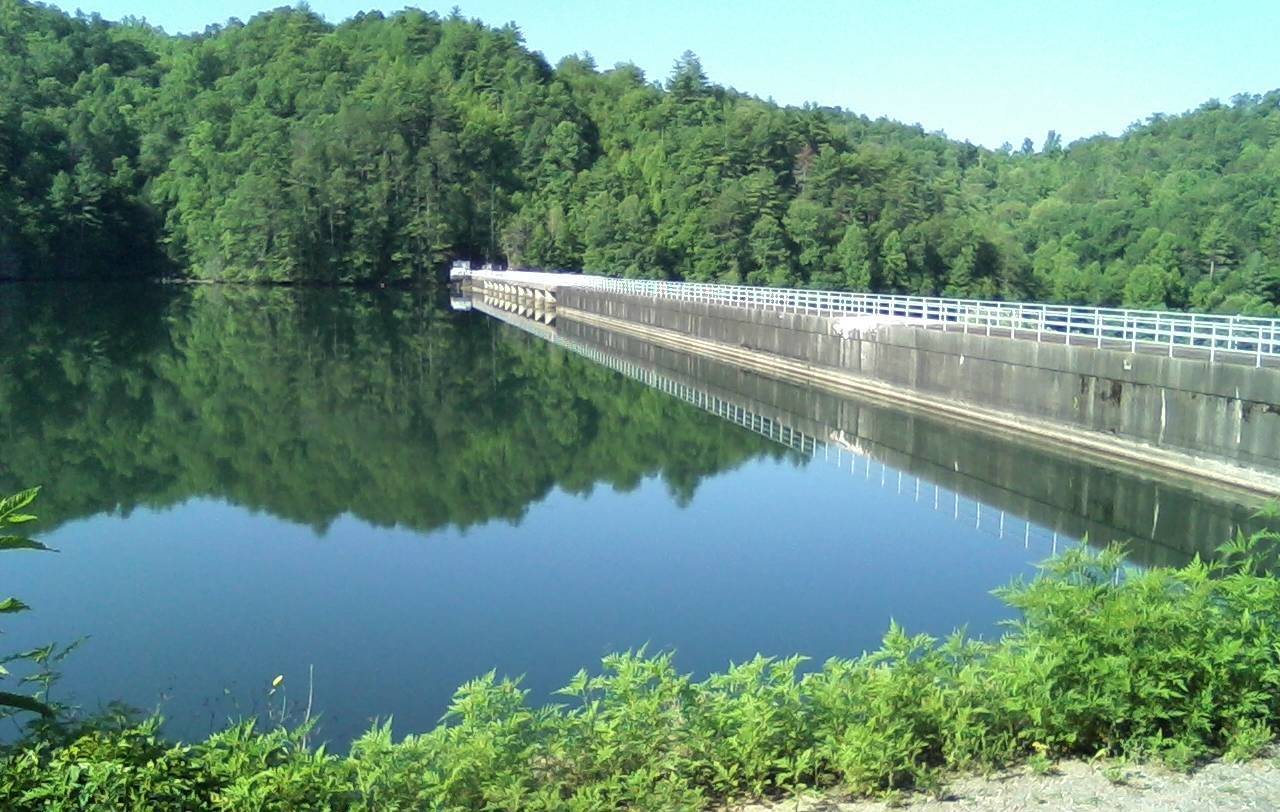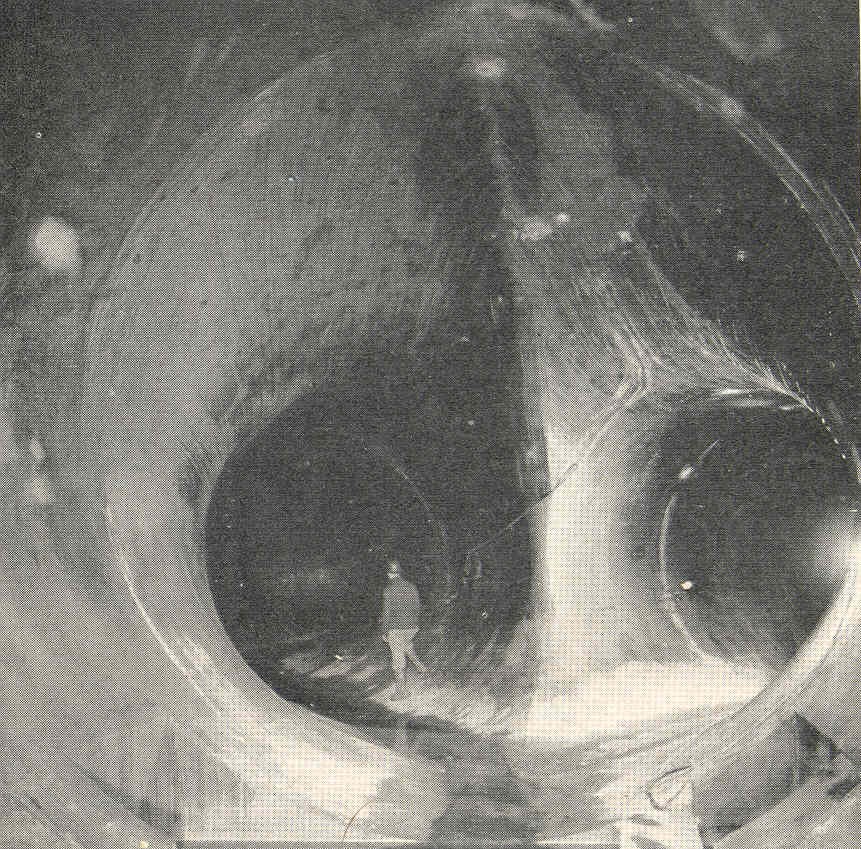Apalachia Dam on:
[Wikipedia]
[Google]
[Amazon]
Apalachia Dam is a

 Apalachia Dam's powerhouse is located downstream from the dam at the base of a steep-walled gorge formed as the river flows between two mountain formations. The dam's conduit— all but of which is underground— passes behind the cliffs on the south side of the river.
Apalachia Dam's powerhouse is located downstream from the dam at the base of a steep-walled gorge formed as the river flows between two mountain formations. The dam's conduit— all but of which is underground— passes behind the cliffs on the south side of the river.
Apalachia Reservoir
Retrieved: 26 January 2009. The dam's spillway is controlled by 10 radial gates with a combined discharge of .Tennessee Valley Authority, ''The Nickajack Project: A Report on the Planning, Design, Construction, Initial Operations, and Costs'', Technical Report No. 16 (Knoxville, Tenn.: Tennessee Valley Authority, 1972), pp. 10-11. Apalachia Lake stretches for to the base of
 Private and public entities had been aware of the hydroelectric potential of the Hiwassee River since the early 1900s. The U.S. Army Corps of Engineers identified several potential dams sites, including Apalachia, in the 1920s, and by the time the Tennessee Valley Authority was formed in 1933, several companies had bought up land and flowage rights in the Hiwassee Valley. TVA took the initiative in the valley, however, with the construction of Hiwassee Dam in the late 1930s. By 1941, the outbreak of World War II in Europe brought a drastic increase in the demand for electricity— especially to support aluminum production in the Tennessee Valley— and TVA quickly put together a plan to build several new dams, including Apalachia, all of which were authorized July 16, 1941. Work began on Apalachia the following day.
Private and public entities had been aware of the hydroelectric potential of the Hiwassee River since the early 1900s. The U.S. Army Corps of Engineers identified several potential dams sites, including Apalachia, in the 1920s, and by the time the Tennessee Valley Authority was formed in 1933, several companies had bought up land and flowage rights in the Hiwassee Valley. TVA took the initiative in the valley, however, with the construction of Hiwassee Dam in the late 1930s. By 1941, the outbreak of World War II in Europe brought a drastic increase in the demand for electricity— especially to support aluminum production in the Tennessee Valley— and TVA quickly put together a plan to build several new dams, including Apalachia, all of which were authorized July 16, 1941. Work began on Apalachia the following day.
 The construction of Apalachia Dam and its reservoir required the purchase of of land, most of which was in possession of three private entities— the Union Power Company, the Hiwassee-Nolichucky Power Company, and the Hiwassee River Power Company, with Union holding nearly half of the . After the initial purchase, the Hiwassee-Nolichucky Power Company sold TVA an additional , nearly tripling the reservation size. Land for the conduit was transferred by the
The construction of Apalachia Dam and its reservoir required the purchase of of land, most of which was in possession of three private entities— the Union Power Company, the Hiwassee-Nolichucky Power Company, and the Hiwassee River Power Company, with Union holding nearly half of the . After the initial purchase, the Hiwassee-Nolichucky Power Company sold TVA an additional , nearly tripling the reservation size. Land for the conduit was transferred by the
Determination of End. Status for ''Pityopsis ruthii'' (Ruth's Golden Aster).
''Federal Register'' July 18, 1985.
Apalachia Reservoir
— official TVA site {{Tennessee Valley Authority Facilities Dams on the Hiwassee River Tennessee Valley Authority dams Buildings and structures in Cherokee County, North Carolina Buildings and structures in Polk County, Tennessee Dams in North Carolina Hydroelectric power plants in North Carolina Dams completed in 1943 Energy infrastructure completed in 1943 Dams on the National Register of Historic Places in North Carolina National Register of Historic Places in Cherokee County, North Carolina 1943 establishments in North Carolina
hydroelectric dam
Hydroelectricity, or hydroelectric power, is Electricity generation, electricity generated from hydropower (water power). Hydropower supplies 15% of the world's electricity, almost 4,210 TWh in 2023, which is more than all other Renewable energ ...
on the Hiwassee River
The Hiwassee River is a
river in the states of
Georgia (U.S. state), Georgia, North Carolina, and Tennessee. It originates from a spring on the north slope of Rocky Mountain (Georgia), Rocky Mountain in Towns County, Georgia, Towns County in n ...
in Cherokee County, in the U.S. state of North Carolina
North Carolina ( ) is a U.S. state, state in the Southeastern United States, Southeastern region of the United States. It is bordered by Virginia to the north, the Atlantic Ocean to the east, South Carolina to the south, Georgia (U.S. stat ...
. The dam is the lowermost of three dams on the river owned and operated by the Tennessee Valley Authority
The Tennessee Valley Authority (TVA) is a federally owned electric utility corporation in the United States. TVA's service area covers all of Tennessee, portions of Alabama, Mississippi, and Kentucky, and small areas of Georgia, North Carolin ...
, which built the dam in the early 1940s to provide emergency power for aluminum
Aluminium (or aluminum in North American English) is a chemical element; it has chemical symbol, symbol Al and atomic number 13. It has a density lower than that of other common metals, about one-third that of steel. Aluminium has ...
production during World War II
World War II or the Second World War (1 September 1939 – 2 September 1945) was a World war, global conflict between two coalitions: the Allies of World War II, Allies and the Axis powers. World War II by country, Nearly all of the wo ...
. While the dam is in North Carolina, an underground conduit carries water from the dam's reservoir to the powerhouse located downstream across the state line in Polk County, Tennessee
Polk County is a county located in the southeastern corner of the U.S. state of Tennessee. As of the 2020 United States census, its population was 17,544. Its county seat is Benton. The county was created on November 28, 1839, from parts of ...
.Tennessee Valley Authority, ''The Hiwassee Valley Projects Volume 2: The Apalachia, Ocoee No. 3, Nottely, and Chatuge Projects'', Technical Report No. 5 (Washington, D.C.: U.S. Government Printing Office, 1948), pp. 1–13, 33, 34–35, 331, 493–494, 517, 526, 531. The dam and associated infrastructure were listed on the National Register of Historic Places
The National Register of Historic Places (NRHP) is the Federal government of the United States, United States federal government's official United States National Register of Historic Places listings, list of sites, buildings, structures, Hist ...
in 2017. Apalachia Dam is classified by the U.S. Army Corps of Engineers
The United States Army Corps of Engineers (USACE) is the military engineering branch of the United States Army. A direct reporting unit (DRU), it has three primary mission areas: Engineer Regiment, military construction, and civil wor ...
as a high-hazard dam, meaning a dam failure
A dam failure or dam burst is a catastrophic type of structural failure characterized by the sudden, rapid, and uncontrolled release of impounded water or the likelihood of such an uncontrolled release. Between the years 2000 and 2009 more than ...
may pose a deadly threat to nearby residents. The dam's condition is not made available to the public due to security concerns.
Apalachia Dam is named for the crossroads community of Old Apalachia, located near the dam site in North Carolina, and the community's L&N railroad stop, known simply as Apalachia, which was further downstream on the Tennessee side of the state line.
Location
Apalachia Dam is located nearly upstream from the mouth of theHiwassee River
The Hiwassee River is a
river in the states of
Georgia (U.S. state), Georgia, North Carolina, and Tennessee. It originates from a spring on the north slope of Rocky Mountain (Georgia), Rocky Mountain in Towns County, Georgia, Towns County in n ...
, which flows northwestward through Northern Georgia
Georgia most commonly refers to:
* Georgia (country), a country in the South Caucasus
* Georgia (U.S. state), a state in the southeastern United States
Georgia may also refer to:
People and fictional characters
* Georgia (name), a list of pe ...
and Western North Carolina before emptying into Chickamauga Lake
Chickamauga Lake is a reservoir in the United States along the Tennessee River created when the Chickamauga Dam, as part of the Tennessee Valley Authority, was completed in 1940. The lake stretches from Watts Bar Dam at mile 529.9 (853 k ...
in East Tennessee
East Tennessee is one of the three Grand Divisions of Tennessee defined in state law. Geographically and socioculturally distinct, it comprises approximately the eastern third of the U.S. state of Tennessee. East Tennessee consists of 33 coun ...
. The dam is situated near the center of a scenic and relatively isolated valley sliced by the river as it winds its way through the southwestern fringe of the Blue Ridge Mountains
The Blue Ridge Mountains are a Physiographic regions of the United States, physiographic province of the larger Appalachian Highlands range. The mountain range is located in the Eastern United States and extends 550 miles southwest from southern ...
. The Unicoi Mountains
The Unicoi Mountains are a mountain range rising along the border between Tennessee and North Carolina in the southeastern United States. They are part of the Blue Ridge Mountain Province of the Southern Appalachian Mountains. The Unicois are ...
rise to the north of the dam, and the Nantahala National Forest
The Nantahala National Forest () is the largest of the four national forests in North Carolina, lying in the mountains and valleys of western North Carolina. The Nantahala is the second wettest region in the Continental US, after the Pacific Nor ...
surrounds the dam and its reservoir on all sides.

 Apalachia Dam's powerhouse is located downstream from the dam at the base of a steep-walled gorge formed as the river flows between two mountain formations. The dam's conduit— all but of which is underground— passes behind the cliffs on the south side of the river.
Apalachia Dam's powerhouse is located downstream from the dam at the base of a steep-walled gorge formed as the river flows between two mountain formations. The dam's conduit— all but of which is underground— passes behind the cliffs on the south side of the river.
Capacity
Apalachia Dam is a concrete gravity diversion-type dam high and long, and has a generating capacity of 93,600kilowatt
The watt (symbol: W) is the unit of Power (physics), power or radiant flux in the International System of Units (SI), equal to 1 joule per second or 1 kg⋅m2⋅s−3. It is used to quantification (science), quantify the rate of Work ...
s.Tennessee Valley AuthorityApalachia Reservoir
Retrieved: 26 January 2009. The dam's spillway is controlled by 10 radial gates with a combined discharge of .Tennessee Valley Authority, ''The Nickajack Project: A Report on the Planning, Design, Construction, Initial Operations, and Costs'', Technical Report No. 16 (Knoxville, Tenn.: Tennessee Valley Authority, 1972), pp. 10-11. Apalachia Lake stretches for to the base of
Hiwassee Dam
Hiwassee Dam is a hydroelectric dam on the Hiwassee River in Cherokee County, in the U.S. state of North Carolina. It is one of three dams on the river owned and operated by the Tennessee Valley Authority, which built the dam in the late 1930s ...
, and contains of shoreline and of water surface.
A steel penstock
A penstock is a sluice or gate or intake structure that controls water flow, or an enclosed pipe that delivers water to hydro turbines and sewerage systems. The term is of Scots origin, and was inherited from the earlier technology of mill pond ...
connects the reservoir intake at the dam site to the conduit. The conduit emerges from a cliffside overlooking the dam's powerhouse, where it splits into two smaller tunnels which carry the water to a valve house. From the valve house, the water drops through two steel penstocks to the powerhouse turbines below. The total elevation drop from lake surface to power house discharge is to , depending on the lake level.
Background and construction
 Private and public entities had been aware of the hydroelectric potential of the Hiwassee River since the early 1900s. The U.S. Army Corps of Engineers identified several potential dams sites, including Apalachia, in the 1920s, and by the time the Tennessee Valley Authority was formed in 1933, several companies had bought up land and flowage rights in the Hiwassee Valley. TVA took the initiative in the valley, however, with the construction of Hiwassee Dam in the late 1930s. By 1941, the outbreak of World War II in Europe brought a drastic increase in the demand for electricity— especially to support aluminum production in the Tennessee Valley— and TVA quickly put together a plan to build several new dams, including Apalachia, all of which were authorized July 16, 1941. Work began on Apalachia the following day.
Private and public entities had been aware of the hydroelectric potential of the Hiwassee River since the early 1900s. The U.S. Army Corps of Engineers identified several potential dams sites, including Apalachia, in the 1920s, and by the time the Tennessee Valley Authority was formed in 1933, several companies had bought up land and flowage rights in the Hiwassee Valley. TVA took the initiative in the valley, however, with the construction of Hiwassee Dam in the late 1930s. By 1941, the outbreak of World War II in Europe brought a drastic increase in the demand for electricity— especially to support aluminum production in the Tennessee Valley— and TVA quickly put together a plan to build several new dams, including Apalachia, all of which were authorized July 16, 1941. Work began on Apalachia the following day.
 The construction of Apalachia Dam and its reservoir required the purchase of of land, most of which was in possession of three private entities— the Union Power Company, the Hiwassee-Nolichucky Power Company, and the Hiwassee River Power Company, with Union holding nearly half of the . After the initial purchase, the Hiwassee-Nolichucky Power Company sold TVA an additional , nearly tripling the reservation size. Land for the conduit was transferred by the
The construction of Apalachia Dam and its reservoir required the purchase of of land, most of which was in possession of three private entities— the Union Power Company, the Hiwassee-Nolichucky Power Company, and the Hiwassee River Power Company, with Union holding nearly half of the . After the initial purchase, the Hiwassee-Nolichucky Power Company sold TVA an additional , nearly tripling the reservation size. Land for the conduit was transferred by the U.S. Forest Service
The United States Forest Service (USFS) is an agency within the U.S. Department of Agriculture. It administers the nation's 154 national forests and 20 national grasslands covering of land. The major divisions of the agency are the Chief's ...
. Since most of the land was in possession of private companies, only 22 families and of roads had to be relocated.
The construction of the conduit was necessary to exploit the stretch of river immediately downstream from the dam site in which the river drops on average per mile. The conduit's tunnel was built using blasting and a drill jumbo, and its surge tank was excavated into the rock near the valve house.
Apalachia Dam was completed September 15, 1942, and its gates were closed February 14, 1943. The tunnel was completed April 1, 1943. The dam's first generator went online September 22, 1943, and a second went online November 17 of the same year. The total cost of the project was just over $24 million (equivalent to $ in ).
Ecology
The construction of the Apalachia Dam eliminated the natural water flow on the Hiwassee River, causing the decline of Ruth's golden aster (''Pityopsis ruthii''), a major reason why the plant was placed on the Endangered Species List in 1985.USFWSDetermination of End. Status for ''Pityopsis ruthii'' (Ruth's Golden Aster).
''Federal Register'' July 18, 1985.
See also
*New Deal
The New Deal was a series of wide-reaching economic, social, and political reforms enacted by President Franklin D. Roosevelt in the United States between 1933 and 1938, in response to the Great Depression in the United States, Great Depressi ...
References
External links
Apalachia Reservoir
— official TVA site {{Tennessee Valley Authority Facilities Dams on the Hiwassee River Tennessee Valley Authority dams Buildings and structures in Cherokee County, North Carolina Buildings and structures in Polk County, Tennessee Dams in North Carolina Hydroelectric power plants in North Carolina Dams completed in 1943 Energy infrastructure completed in 1943 Dams on the National Register of Historic Places in North Carolina National Register of Historic Places in Cherokee County, North Carolina 1943 establishments in North Carolina